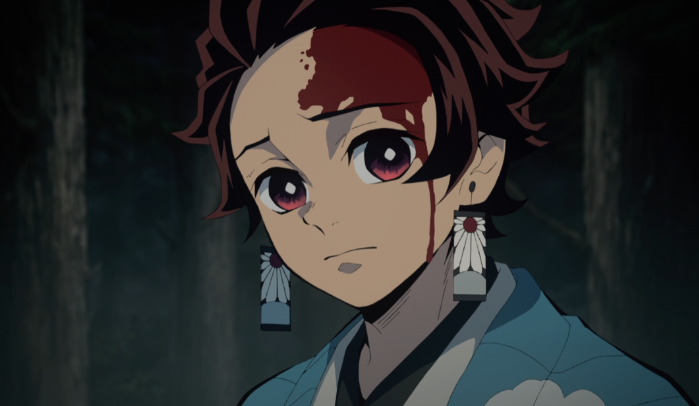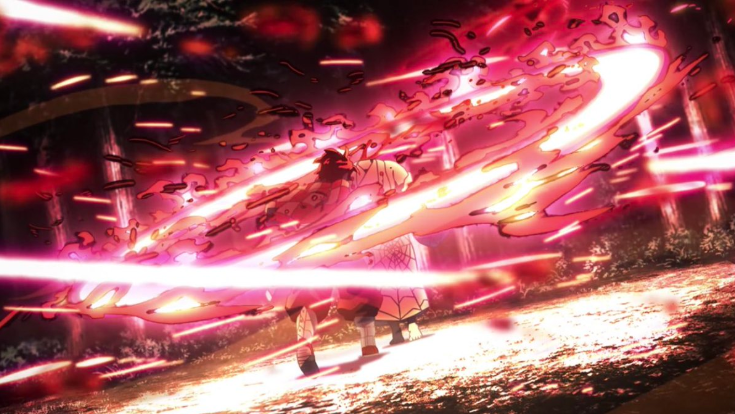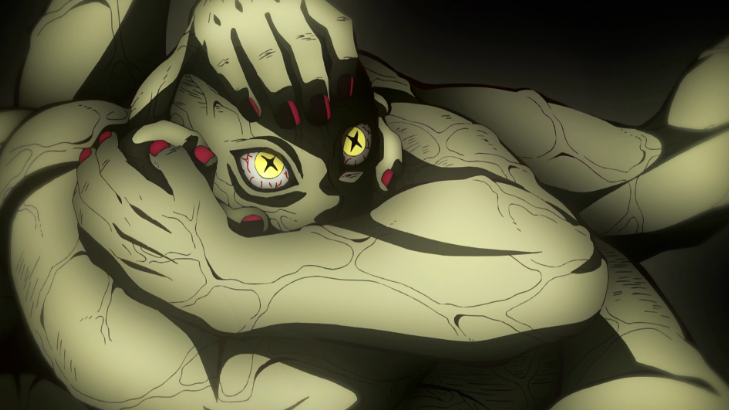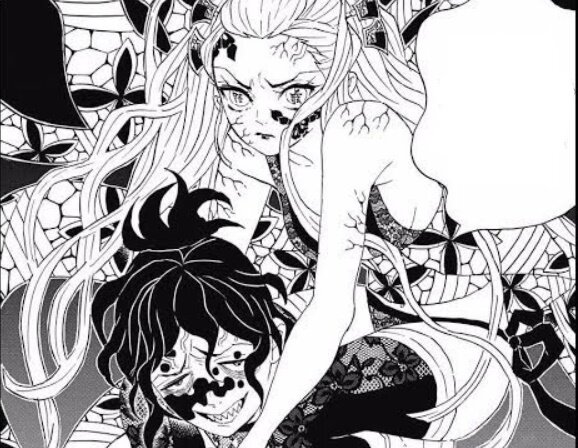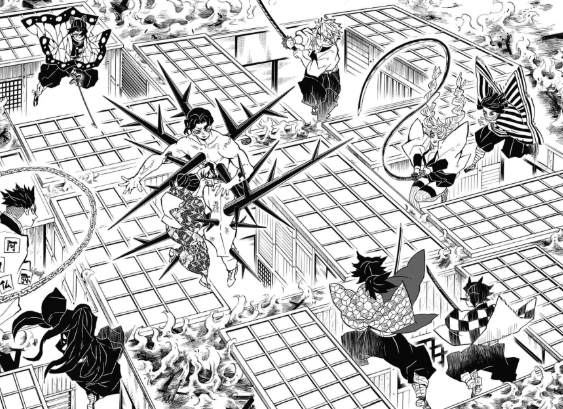Thoughts on... Demon Slayer, One Piece, and Overwhelming Flashbacks
sweet boy tanji
I’m on Twitter too much and I think I need a detox, but it gives me so much inspiration it's hard to abandon. The online community is in this weird state right now where fans of various series are desperately trying to create a next Big Three for the 2020s, not quite understanding that the original Three was not so much a title of merit (although the qualities of Bleach, Naruto, and One Piece can’t be denied) but more so relating to an era: when there was less choice in what was serialised and published in Western countries, making it easier for three very popular Shonen Jump series to dominate the conversations of Western fans. Many people my age (mid to late twenties) first joined the “community” because of the Big Three, and at that time, it was guaranteed that everyone else had read or watched if not one or two, but all three.
Things are different now. Oftentimes I meet fans in their early twenties and below who have never engaged with any of them, particularly One Piece, put off by the daunting 900+ chapters and episodes. Back in the day, that was so rare I don’t think many people would have admitted it. Remember that episode of Recess where Vince misses NitWitz 3, and everyone in the whole school is shouting me no know! And he feels like a total bellend and breaks curfew just to keep abreast with his peers? Well, back then, the Big Three popularity was just like that. Nowadays, all the choice, the access, the widening sphere of social media which in turn opens fans to more diverse content, makes it impossible to narrow down the popular series to just three titles. That era is gone, and knowing that so many fans don’t even know what the Big Three means makes me feel a little old—wistful too, as I remember the close-knit homogeneity of my One Manga days.
Pls stop doing this.
But change isn't a bad thing.
These days, a myriad of series run astride the continuing One Piece in popular shonen discourse. The Promised Neverland is certainly one, Attack on Titan is another. Fire Force and Dr Stone are both wildly popular. Fairy Tail and now Eden’s Zero are doing well, along with Hajime no Ippo, Seven Deadly Sins, My Hero Academia, Diamond no Ace and Haikyuu! The list goes on, with all the fandoms sharing alternating space on the stage. One series has been of interest to me since the anime launched in 2019. I enjoyed the animation, the main cast, the OST and the fighting system so much that I, like millions of others, transitioned onto the manga, contributing to an unspeakable boost in sales that rivalled the Big One. The sales figures ignited flame wars, intense rivalries, and heated arguments online. It even won animation of the decade (not anime of the decade), even though the anime only launched during last decade's final year. It’s garnered much ire from smaller fandoms who see it as a recipient of the most blatant recency bias to the detriment of other worthier titles, and others who chalk the popularity solely to the anime's production. Ufotable did amazing things with it, but I do think Demon Slayer has a little more to offer than animation trickery.
The episode that started the drama: it trended #1 on Twitter and piqued normie interest.
Tanjiro Kamado is a kind and honest fifteen-year-old who lives in a world where demons exist. They kill and eat humans for sustenance, and although their presence has been felt in many communities, their existence is somewhat fabled amongst the wider public. Tanjiro’s family is killed by a demon and the only survivor is his sister Nezuko, however the attack left her partially demonised. She is unable to speak and cannot see the sun, so Tanjiro must carry her in a wooden case on his back during the day. Nezuko has demonic strength now, and she regularly risks her life to save Tanjiro during times of trouble. After meeting the mysterious Giyu, Tanjiro enlists on the demon slayer corps to hunt down Muzan Kibutsuji, the progenitor of all demon life, and return his sister to normal. However, to reach Muzan, he must defeat the six Upper Moons: the crème de la crème of demon-dom, and Muzan’s most powerful creations. Along the way, he befriends the cowardly Zenistu and the boisterous Inosuke, and gains the respect of the Nine Pillars, the elite fighters of the demon slayer organisation.
I’ve been stuck in a rut of very typical shonen series of late, so I have become overly accustomed to loud, eccentric and boastful protagonists, young men who are the best in their field, who settle things with their fists, and have some secret power that puts them unfairly above everyone else. Tanjiro is different. His kind attitude is what draws people towards him first—not so much talk no jutsu, more actually-show-kindness-and-get-results. His ability to show compassion towards the demons who destroyed his and many others’ lives is admirable as it is bewildering to his colleagues. The demons also express awestruck confusion at this young slayer’s morose countenance during his killing blows.
Depressed Mother Receives Tanjiro Special
I also enjoy the fighting style. It’s been a while since I’ve seen swordsmanship as a main fighting system, and not since Bleach have sword fights been so compelling. In Demon Slayer, the battles are stunning, with each character relying on elemental forms for their parries. Koyoharu Gotouge draws this beautifully: there will be pages of Hokusai-esque waterfalls to illustrate breath of the water, jagged lightening for the thunder form and a cluster of butterfly wings for breath of the insect. Character designs vary, ranging from unique to bizarre, pretty to complicated. All the while, the threat of Muzan grows stronger, and his constantly changing appearance heightens the tension and mystery of his character: you never know what form he will take, and when he does appear, it is a shock to both demon slayers and his own Lower Moons, who apparently have never seen his true demonic form.
There are other aspects of the story that are generic. Tanjiro later develops a secret power that no one else can identify, and although the series seems to be on its final arc, we have yet to properly know what this power is, who it comes from, or what it does. There is little explanation of as to why Nezuko can’t speak anymore, so we have yet another female protagonist whose importance is eclipsed by the main male’s journey. The world isn’t as fleshed out as other series; it takes a little while for the reader to realise that demon slayers are a clandestine existence in the manga’s setting, which is unusual considering how many humans have had their lives ruined by demons themselves. In general, the series feels too short, but some individual arcs are too long—the latest arc, for example, reminds me of some of the slow, drawn-out fights in Bleach’s Hueco Mundo arc, with pages of monotony and endless exposition, only for an underwhelming slash to signal the end of the fight. Furthermore, the battles are made longer because of Gotouge’s use of flashbacks.
First he was all “hee hee hee!” and then he died :(
Flashbacks are a common literary device in manga and anime. A character’s nature and motives are often explored in black-bordered sequences, by the end of which the reader should feel some sort of empathy, sympathy, or at least general understanding. Sometimes, flashbacks fall short and can be cheapened by the author’s obvious attempts to shove everyone on the feels train: in many shonen flashbacks, expect lots of death, abuse, and especially murdered wives, sisters, and mothers. Other times, flashbacks work.
In Demon Slayer, flashbacks serve a purpose. One of the main themes of the series is redemption, and how past trauma affects current events. All the characters, human and non-human alike, have had their lives forever changed because of an encounter with a demon. Sometimes, those people succumb to such despair that they surrender their livelihoods to Muzan and become demons themselves, continuing the cycle of horror. Others put their trauma to good use and choose to become demon slayers instead. The epicentre of each character’s misfortune runs a jagged fault throughout the narrative, with the two sides of demon slayer and demon often crossing paths not only in terms of battle, but through the empathy of shared experience. They are tied together by Muzan, after all, so it is inevitable that over time, the rules of hero and villain become more obscure and difficult to identify. Because everyone’s relationship with Muzan is so important to their current activities as demons and slayers, it is necessary for the reader to have some insight into the events leading up to their current occupations.
He only wanted to be a writer :(
As such, during the moment of certain death, the demons reminisce on the events that led to their unworldly transformation. The memories of their trauma return, and thoughts that they had not entertained for years assault and immobilise them in the face of the lowering slayer blade. After spending decades or centuries running from the weakness of their humanity, their very-human death provides a cyclical lesson for the demons. Forsaking the very thing that makes the human experience human itself is not a healthy way to manage trauma, and turning over to the demon world changed nothing about the past, nor did it heal them. These memories, and the resultant tears, are proof that in all that bloodshed, they were still very much in pain, and used their demon states to mask it. The flashbacks are far from contrived: the demons die as villains, and sometimes they envision their loved ones who had perished too soon, crossing over to heaven whilst they descend elsewhere with regret, openly facing the atonement/punishment that is their due for causing so much pain to others. The accountability factor is an element of Demon Slayer flashbacks that I admire, as too often, shonen authors attempt to completely redeem a heinous character with a couple of black-limned panels. It rarely works.
On the other hand, there are times when it clutters the narrative. Every significant demon fight has had a two or more-chapter flashback just before one of our heroes lands the finishing blow. The first few times this happened, they had an impact. After the fourth or fifth time of yet another emotional flashback in the exact same part of a fight, it begins to kill the tension of an otherwise exciting sword sequence. Right now in the manga, Tanjiro, friends, and Pillars are fighting Muzan. Before this ultimate battle, the slayers split into teams to kill his Upper Moons, and each battle comes with its own demon flashback. One flashback was really quite touching, but because very little was seen of Akaza save his surprisingly brief battle with Rengoku, it was hard for me to feel as emotional as Gotouge probably intended. After a while, it begins to feel like the flashbacks are there to substitute for character development, so instead of an arc exploring the demon society, their interactions with Muzan, perhaps a few moments of them visiting their hometowns or coming into contact with humans that remind them of their past lives, everything is condensed in those two pre-death chapters. The tragedy of their pasts gets cheapened after a while, and as a reader, you begin to anticipate exactly who will die and when.
*fade to black*
Even worse is how the frequency of the flashbacks dissolve the mystery of the fights. As soon as the panels fade to black, it is guaranteed that the demon will die in this fight, and imminently. This trend made the battle between the mysterious Upper Moon One, Kokushibo, really lacklustre, as the flashback started and he had yet to meet Tanjiro and explain his connections to the Kamado family. Instead, we were given a full backstory about his rivalry with a brother we do not know, but apparently his fractured fraternity was a monumental factor in him choosing demonhood. I honestly couldn’t feel much for Kokushibo’s identity crisis, because I was still overcoming my surprise at the inevitable death of the demon that had been fated as the strongest, most dangerous, and most important to the protagonist’s unknown past. This death flag had come too early in my opinion, and I wanted to know more about him, his brother, and Tanjiro’s ancestors. For such an important character, a flashback wasn’t enough. We needed character development.
So far, Muzan’s motives have not been fully explained. I would hate to think that he too will be relegated to a random flashback at his end, that he will die like Kokushibo, leaving behind more questions than answers. It doesn’t help that the fight itself has started to drag, padded with afterlife sequences for fallen heroes, walls of internal monologues, and every in-fight powerup amounting to nothing as Muzan effortlessly swats the slayers away. The fight doesn’t really have a lot of tactical elements, no clever techniques: Muzan is just motionless whilst a bank of tendrils whip about his head, Gooper Blooper-style, slapping the demon slayers into a stupor. Any more flashbacks and the fight really will shudder to a stop. We’ll need more than a black panel to resolve it satisfyingly.
*jumps*
As this essay started out with a tenuous comparison to One Piece, I think it’s relevant to mention it here again only because the constant debates surrounding the two puts the strengths and weaknesses of both into perspective. One Piece has its issues, but Oda’s ability to develop characters through experiences alongside their flashbacks are what distinguishes his series from some of the newer crop of Shonen Jump titles. Every member of the Strawhats has had a full or partial flashback arc that explains their current situation. The flashbacks are not substituted for character development, but they help to give a reason behind their present behaviours, or reveal something previously unknown.
For example, Luffy’s Goa flashback introduced Sabo and explained the major questions raised from Ace’s parentage reveal. Nami’s explained her thievery. Robin’s opened an entire storyline about the corruption of the World Government, the Ancient Weapons and the Void Century—it also assuaged any suspicions for readers and crew-mates about her loyalty. Zoro, Sanji, Franky, and Usopp all had flashbacks that explained their goals, the motivations behind their goals, and gave some background to their quirky character traits—Sanji’s second flashback revealed his true lineage. Brook and Chopper required flashbacks because they allowed readers to see how their Devil Fruits affected their lives up to the present day. Additionally, Brook’s origin story tied him to Laboon, and gave him a reason for joining the Strawhats.
LABOOOON!
These characters all developed further through their activities in the present day. Usopp grew braver and more skilled by challenging himself and being placed in challenging situations; Chopper learned to control Monster Point through hard work; Luffy now relies on people and forms alliances when he’s up against a formidable foe—in fact, Luffy’s ability to detect formidable foes is only present because of his crushing defeat at Saboady and Ace’s subsequent death. The flashbacks of these characters provided some retrospection, not development.
To make a fairer comparison to Demon Slayer, I could mention the Senor Pink vs Franky fight, as well as the Luffy vs Katakuri battle. Both fights had a flashback interspersed throughout the present events, but I think they were both used more effectively than what we’ve had in Demon Slayer so far. Firstly, Senor Pink stands out from the Doflamingo Family because he’s a grown fucking man in baby cosplay. Anyone with sense would want to know why he looks like that, and why, despite being Franky’s enemy, he is sworn to an overly chivalrous code of manliness. The fight itself is quite dull, with the equally matched men going blow for blow with very little development. It was clear that whoever got tired first would lose, but it’s a shame that nothing particularly exciting happened during their struggle. However, when we transition to black, Senor’s history unfolds as a hardboiled gangster who fell in love, poorly balanced his family life with his criminal activity, and ended heartbroken, childless, and with a wife who exists in a vegetative state. Dressing like a baby triggered her first smile, and ever since, he has donned the bonnet, nappy and pacifier to reclaim his lost honour. It also explains why he shuns trickery during his fight with Franky. Even if he is a bad guy, he still wants to retain his pride.
…and we all took him very seriously.
Similarly, Katakuri, the solemn stalwart of the Charlotte family, hid a secret during his fight with Luffy. His rugged scarf conceals a monstrous mouth in which he stuffs indulgent sweets, and he does rest on his back—regularly. The reveal of big bad Katakuri singing to his giant doughnuts, reclining on a soft chair with a cup of sweet tea in his hand, is such a classic One Piece moment, and yet it still shocked and humoured me. Those insane transitions are typical for the series, like the enigmatic Kaku turning into a giant giraffe to fight Zoro and Usopp, or the revolting Walpol of Drum Kingdom casually munching into artillery and fortresses to defeat his enemies. The random intrusion of Katakuri’s merienda gets picked up later in his flashback, where we get a reason for his public aversion to the ground, and a reason for why he covers his mouth—and why Brulee has a scar.
Poor guy is HUNGRY.
I love the flashback because during the fight, Katakuri, like Senor Pink, maintained an honour unique among villains. When Luffy is handicapped by Flambe, Katakuri stabs himself in the side to level the playing field. Whenever Katakuri speaks or makes a move, the Charlotte family and their allies look on in awestruck wonder. When Flambe sees his face and runs off in horror, Katakuri sighs in embarrassed disappointment. He then murders the three chefs who saw, revealing how seriously he takes the revelation. These incidents foreshadow the flashback. We are provided with enough clues as to Katakuri’s true nature—that he is a noble and admirable adversary, with a strong sense of honour, courtesy and family loyalty. His flashback sympathises him because it looks so exhausting to maintain a strong, elusive presence constantly, when really all he wants to do is kick back and eat cake. The flashback helped to marry the character we already know in the present with his childhood past. Without the development beforehand, it would have been too forced. A flashback can only do so much if the character is still a cardboard shape.
Aside from the intrusive flashbacks, Demon Slayer is a compelling story, and Gotogue is excellent at developing the heroes. Inosuke is a perfect example of this. The wild, socially inept fighter is so enjoyable and gives some comic relief to a story that is otherwise quite depressing. In recent chapters, his flashback revealed why he’s so crazy. Interestingly, Inosuke’s origin story ties into the flashback of Doma, Upper Moon Two, who happens to be the only high tier demon that doesn’t have a sob story to counter his demonic acts, nor is he remorseful. It offsets Inosuke’s brash innocence wonderfully, and adds more depth to a fight that was already devastating.
*FADE TO BLACK*
I think most of the criticism thrown towards Demon Slayer is mean-spirited. Do I think it deserved animation of the decade? Definitely not. Do I think it deserves its current success? Absolutely. It’s great seeing a female shonen mangaka get some limelight again, and although there are some generic elements to the manga, there are plenty of unique and powerful aspects of the story that are evidence for its popularity. Not every story can be perfect, however. If we really are nearing the closing chapters of Demon Slayer, I really hope that Gotouge ends it well, with a suitably fitting conclusion for Muzan, and a full resolution for our heroes. We just need more character development, because some stories simply cannot be told effectively enough with a flashback panel. We need to experience it, to feel what the characters feel, and cheer them on accordingly.
